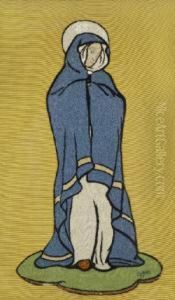Lili Yeats Paintings
Lili Yeats, born as Elizabeth Corbet Yeats on March 25, 1866, in London, England, was an influential figure in Irish arts, particularly known for her contributions to embroidery and printing. She was part of the talented Yeats family, with her brother W.B. Yeats achieving fame as a poet and her sister Susan Mary (Lily) Yeats also being involved in the arts. The Yeats siblings were deeply embedded in the cultural revival of Ireland at the turn of the 20th century, a period that sought to promote Irish art, literature, and heritage amidst the political tensions leading to Ireland's independence.
Lili's early life was marked by frequent moves due to her father's career as a portrait painter and her family's financial instability. This nomadic lifestyle, however, exposed her to a variety of artistic and cultural environments. Despite the family's financial difficulties, Lili and her siblings received an education that emphasized the arts, which was not common for women at the time. In the 1890s, Lili and her sister Lily attended art school in London, where they were trained in the Arts and Crafts movement, a philosophy that advocated for traditional craftsmanship and its importance in the modern age.
Lili's career took a significant turn when she, along with her sister Lily, became involved with the Dun Emer Guild in Ireland, an arts and crafts community founded by Evelyn Gleeson in 1902. The Guild aimed to provide employment for women in the arts and crafts and was part of the broader Irish Cultural Revival. Lili was responsible for the embroidery workshop, where she applied her skills and knowledge to create works that were deeply rooted in Irish tradition yet innovative in design. Her work during this period contributed significantly to the revival and appreciation of embroidery as a serious art form in Ireland.
In 1908, Lili and her sister Lily left the Dun Emer Guild due to creative differences and founded the Cuala Industries. Lili took charge of the Cuala Press, a private press that was an extension of the Yeats family's deep engagement with Irish literature and the arts. The press became known for its beautifully crafted books, many of which were illustrated by their brother Jack B. Yeats and contained works by W.B. Yeats and other prominent Irish writers. Lili's meticulous attention to detail and her dedication to the craft of printing helped establish the press as a significant contributor to the Irish Literary Revival.
Lili Yeats's contributions to Irish arts and crafts, particularly through her work with embroidery and the Cuala Press, have left a lasting legacy. She was not only a central figure in the Irish Cultural Revival but also a pioneer for women in the arts during a period when their participation was not widely recognized. Lili Yeats passed away on January 16, 1949, in Dublin, Ireland, leaving behind a body of work that continues to be celebrated for its beauty and craftsmanship.
